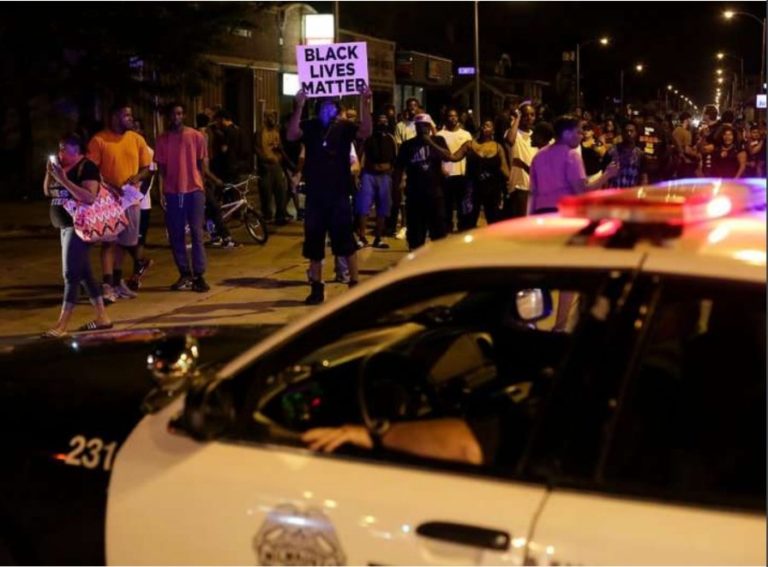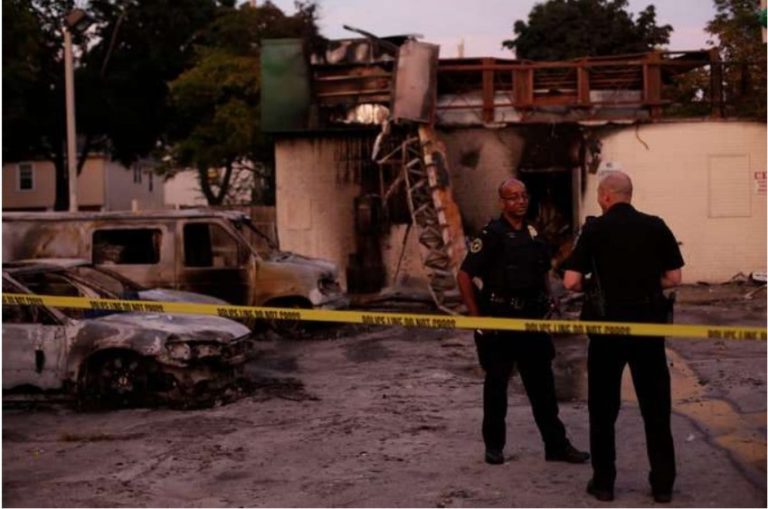Milwaukee Shaken by Eruption of Violence After Shooting by Police
By Kay Nolan, August 15, 2016
A version of this article appears in print on August 15, 2016, on page A10 of the New York edition with the headline: Milwaukee Is Shaken by Eruption of Violence.

MILWAUKEE — Like many of his neighbors, Dominic A. Lebourgeois was in disbelief on Sunday at the level of violence that descended on his Sherman
Park neighborhood the previous evening.
“I’ve lived here for 30 years, and I’ve never seen anything like this in my life,” said Mr. Lebourgeois, 53, a self-employed handyman.
Hours after a police officer shot and killed a fleeing armed man, angry crowds confronted the police and then went on a rampage, destroying property, setting fires and throwing rocks and other missiles at officers. At least half a dozen businesses, including a gas station and an auto parts shop, were destroyed.
“I think it’s crazy, it’s ludicrous,” Mr. Lebourgeois said. “These are the stores we shop in. I got a feeling they’re going to move instead of rebuild.”
The violence reignited on Sunday night when the police said gunfire erupted during disorderly protests at three different intersections in the
predominantly black neighborhood of Sherman Park.
Protesters pelted officers with debris, the department said, and at least one person was shot. Police officers used an armored vehicle to extricate the
victim from the crowd and take that person to a nearby hospital.
Around midnight, the Police Department said on Twitter that it was “working to restore order” in the area. “The National Guard has not been called to the
areas of disturbance,” it said.
Earlier in the day, neighborhood volunteers cleaned up the debris left in the aftermath of the previous night’s unrest. But the neighborhood and city
remained on edge.
Gov. Scott Walker declared a state of emergency and activated the Wisconsin National Guard to aid local law enforcement, if needed. The Milwaukee Police Department and Milwaukee County Sheriff’s Office planned to deploy additional personnel, Police Chief Edward A. Flynn said at a news conference on Sunday.
During that appearance, Chief Flynn identified the shooting victim as Sylville K. Smith, a 23-year-old African-American. Police officials and Mayor Tom
Barrett said that a video taken by a police body camera showed that Mr. Smith was armed with a handgun at the time he was shot.

Chief Flynn also confirmed that the 24-year-old officer who shot Mr. Smith was black, but he did not release the officer’s name.
“He happens to be African-American, with several years of experience, and he’s a very active officer,” Chief Flynn said. “And we are concerned for his
safety.”
Saturday’s shooting and the subsequent outburst came as communities across the nation scrutinize what many see as the excessive use of force by
law enforcement, particularly against black people.
In Sherman Park on Sunday, many expressed similar concerns of overly aggressive policing.
Mr. Lebourgeois said that he did not condone violence and that he advocated cooperation with the police, but he also remarked: “It seems to me they’re
doing a lot of shooting people. I don’t know if these guys are bringing it on themselves or not. That’s why I just try to stay out of the way. But I know
nothing like this is happening on the south side.”
On Sunday afternoon, about 100 people, most of them black, held a peaceful demonstration — holding hands and praying — in front of O’Reilly Auto
Parts, one of the burned-out businesses.
Carol Office, 50, watched the prayer rally from a short distance away. She identified herself as the aunt of Mr. Smith, the shooting victim, and said she had spent the day “crying and praying.”
She held a poster covered in pictures of black slaves and Bible verses about slavery and said police shootings of black people made her feel like “we’re
back in chains.”
“They are supposed to serve and protect us, but they shooting us,” Ms. Office said.
Jessie Griffin, a pastor at Greater New Birth Church, who led the rally, said he wanted the crowd to pray for the police.
“At the end of the day, we need our law enforcement officers,” he said. “If I have a problem in my home, I’m going to call 911. I’m going to pray for them
because they have a pretty hard job to do.”
Afterward, the group marched to the nearby District 7 police station, where the participants held their arms in the air.
Another fire on Saturday, at a gas station in Sherman Park, burned unattended while gunshots kept firefighters from extinguishing it. In all, six
businesses were set on fire, Chief Flynn said. Several squad cars were damaged and four officers were injured, all of them treated at a hospital and
released. Seventeen people were arrested.
In a statement, Mr. Walker praised volunteer cleanup efforts on Sunday morning.
“This act of selfless caring sets a powerful example for Milwaukee’s youth and the entire community,” he said. “I join Milwaukee’s leaders and citizens in
calling for continued peace and prayer.”
Mr. Walker noted that, under Wisconsin law, the shooting was under independent investigation and he asked that people give police officers “the
respect they deserve for working so hard to keep us safe.”
He said he decided to make the National Guard available after consulting with Mr. Barrett and the Milwaukee County sheriff, David A. Clarke Jr., and
in light of the events on Saturday night.
Many of the protesters on Saturday were black, and Alderman Khalif J. Rainey expressed the frustration within the community. “The black people of
Milwaukee are tired,” he said. “They’re tired of living under this oppression.
“What has happened may not have been right,” Mr. Rainey said. “I’m not justifying that, but nobody can deny that there are racial problems here in
Milwaukee, Wisconsin, that have to be rectified.”
The violence overnight Saturday erupted after an officer killed Mr. Smith, who the police said was armed with a semiautomatic handgun and who fled
after a traffic stop.
The police said two uniformed officers stopped two people in a car around 3:30 p.m. Saturday. The police did not provide details on why the car was
stopped beyond describing it as raising suspicion.
Both occupants immediately ran from the car. During the pursuit, an officer ordered Mr. Smith to drop his gun and fired when he did not, striking Mr.
Smith in the chest and an arm, Mr. Barrett said Sunday morning. The gun held 23 rounds, he said. Mr. Smith died at the scene.
Chief Flynn said that Mr. Smith had a lengthy arrest record with the Milwaukee police. The authorities have no immediate plans to release video
from the shooting, Chief Flynn said, though he did describe what it showed.
“This event probably took 20 to 25 seconds,” he said. “I mean, there was virtually no time between the officer unhooking his seatbelt, turning on his
body camera, getting out of the car and immediately there was a foot chase.”
The officer’s actions, as recorded, appeared to him to be “credible and legally protected.”
The Wisconsin Department of Justice will conduct the investigation into the shooting because the case involves a Milwaukee police officer.
The Saturday shooting was part of a weekend filled with violence in Milwaukee. Five people were shot and killed overnight Friday, Mr. Barrett
said on Saturday at a news conference recorded by The Milwaukee Journal Sentinel. At least two of those shootings occurred near where Mr. Smith was
shot.
Kay Nolan reported from Milwaukee, and Niraj Chokshi from New York. Liam Stack and Christopher Mele contributed reporting from New York.